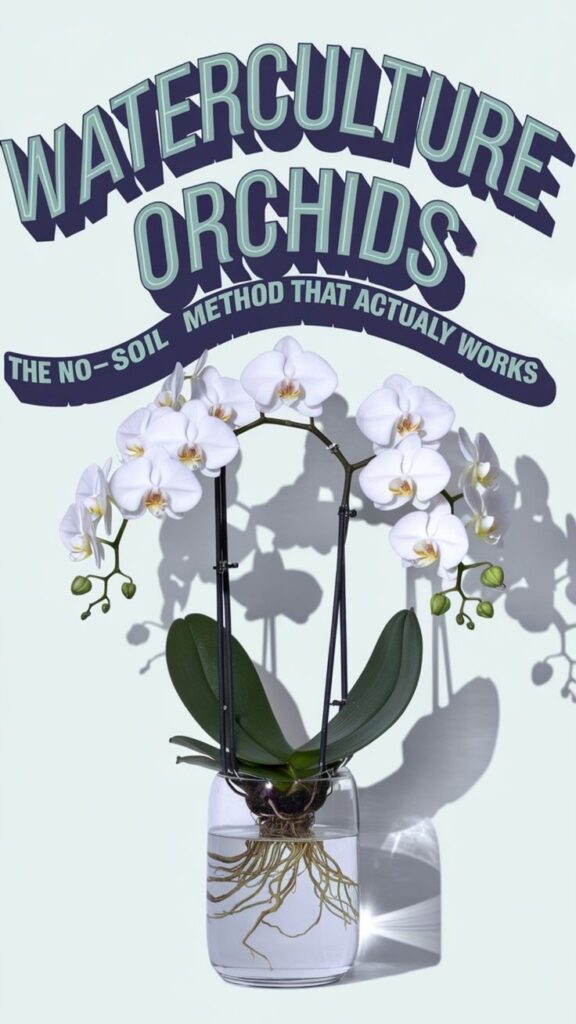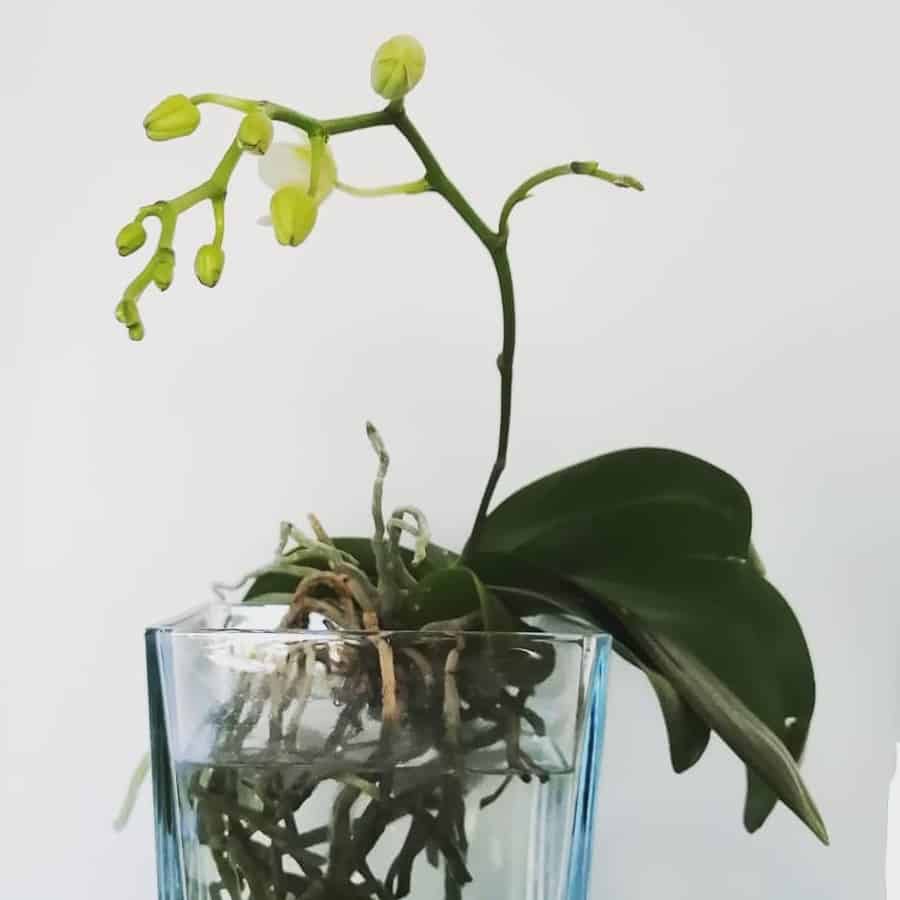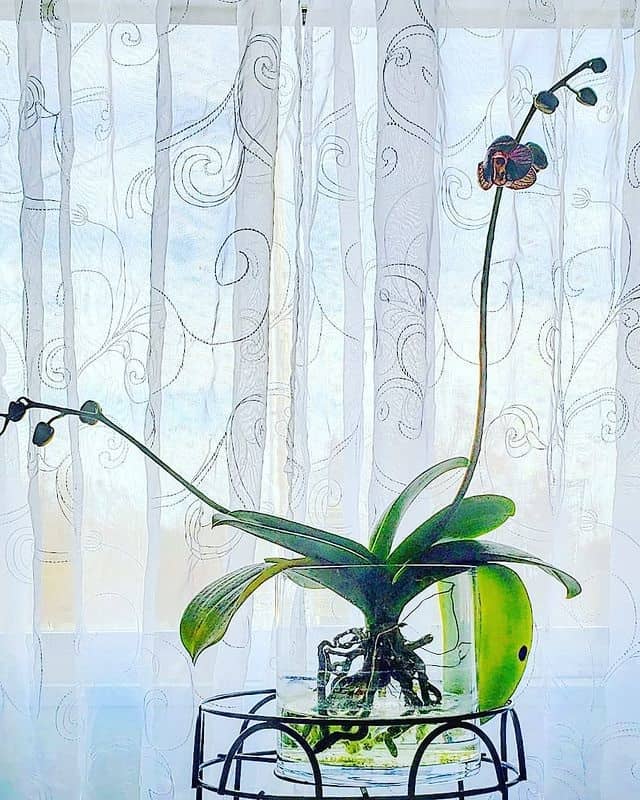Growing orchids in water requires relatively minimal upkeep compared to traditional methods; it’s inexpensive, easy to maintain, and offers plenty of opportunities for experimentation so you can develop unique styles and techniques as time goes on. In this article, we’ll discuss how to grow orchids in water. So let’s dive right into it!

Have you ever been captivated by an orchid’s beauty and wondered how to grow one of your own? Then growing an orchid in water is the perfect way for you to get started! With a little bit of effort, you can have a stunning plant that will bring life and joy into any home. Growing orchids in water not only gives instant gratification but also eliminates most of the difficulties associated with soil-based gardening.
Contents
Can You Grow Orchids In Water?
Growing orchids in water? It may sound counterintuitive, yet it is possible. With a few supplies and some simple steps, you can have an abundance of healthy flowering orchid plants to admire for years to come.
In order to grow orchids in water, their roots must be submerged. Then, these roots will easily absorb nutrients from the solution they are planted in. For example, when using distilled water to grow your orchids in, adding liquid fertilizer every other month will help them thrive.
When growing orchids in water, it is important that you keep the level of the solution consistent with how deep the plant’s roots were initially submerged. Adding too much liquid can cause root rot while not enough can dehydrate them; both scenarios could lead to detrimental effects on your plant’s health. Additionally, maintain adequate light levels and temperatures so that your plants stay healthy and happy all year round!
How To Grow Orchids In Water

It may surprise many to know that the number of people growing orchids in water is rapidly increasing. This method of propagation, known as water culture, has become quite popular among orchid enthusiasts due to its ease and success rate. Growing epiphytic orchids in a container filled with just enough water for the roots to be submerged can bring about an impressive display of flowers. If you are looking for an easy way to grow your own vibrant tropical plants, then this guide will provide everything you need to know on how to successfully grow orchids in water.
The most important thing when it comes to achieving success with orchid water culture is maintaining the correct level of hydration. Keeping the bottom part of the plant’s root system below the surface at all times ensures they get sufficient moisture while avoiding overwatering which could lead to root rot. To do this, use a transparent vessel so that you can keep track of how much liquid needs replacing regularly.
Another critical aspect to consider when setting up your water culture environment is selecting suitable inert materials such as leca clay pebbles, pumice, stones, etc., which help promote air circulation around the roots and create an ideal rooting medium for epiphytic orchids. Additionally, fertilizers should be included in every other watering session during active growth periods as these essential nutrients help stimulate strong healthy blooms and lush foliage throughout the year.
Finally, controlling temperature fluctuations is also paramount if one wishes their orchid’s health to remain optimal over time; try keeping them away from direct sunlight and cold drafts whenever possible–indoors usually works best here! With proper care given following these guidelines outlined above, even novice growers have found themselves enjoying beautiful displays of colorful flowers within months after planting their very first epiphytic orchid in water.
Related Post:
How Long Do Orchids Live?
Advantages Of Orchid Water Culture

Growing orchids in water has become increasingly popular amongst orchid growers. This form of culture, known as ‘water culture’, is an easy and low-maintenance way to grow beautiful plants such as the moth orchid. Let’s explore some of the advantages that come with choosing this method for your orchid growth journey.
One advantage of growing orchids via water culture is that it requires less frequent watering than traditional substrate-based methods. The roots are able to absorb all the nutrients they need from the liquid solution, which means you don’t have to worry about over-watering your plants! Additionally, since there is no risk of root rot when using this method, it’s perfect for those who may not be experienced with caring for their plants yet.
Furthermore, because of the lack of soil involved in water culture, you get a better view of how healthy and strong your plant’s roots are. When checking on your plant’s progress throughout its growth cycle, you’ll be able to accurately gauge whether any adjustments need to be made – such as adding more fertilizer – without having to dig through dirt first.
Finally, unlike many other kinds of plants, it can actually be beneficial for some types of orchids if their roots sit in water permanently; this creates an ideal environment where they will thrive and develop healthier flowers than they would otherwise. For these reasons, it’s no surprise why so many people choose the water culture route when cultivating their beloved orchids! With all that said, however, before taking up this method we must also consider potential drawbacks…
Disadvantages Of Orchid Water Culture
Growing orchids in water culture has many advantages, but there are a few drawbacks to consider too. For starters, you won’t be able to use direct sunlight when growing an orchid this way. Without the light of the sun providing warmth and energy for photosynthesis, your plant may not thrive as it would outdoors.
Another disadvantage is that while water culture can help with root growth, it’s also more prone to fungal infection than soil-based cultivation. This means you need to check on your plants regularly and take any necessary steps if you spot signs of disease or pests.
You’ll also need to make sure that the water stays at a consistent temperature – cooler temperatures will cause the roots to die off quickly, while warmer ones could encourage pest infestations. The pH level of the water should be monitored carefully as well; too much acidity or alkalinity can prevent proper nutrient absorption by the roots.
Finally, without access to natural fertilizer from soil amendments like compost, manure, and mulch, you’ll have to manually provide your plants with nutrients every few weeks in order for them to remain healthy. This requires careful consideration and dedication in order for successful results.
With all these risks taken into account, it becomes clear why some people opt out of growing orchids in water culture despite its benefits – so what other options do we have?
What Orchids Can You Grow In Water Culture?

Growing orchids in water culture is almost like a superpower! It’s an incredible way to nurture these delicate flowers without making even the slightest of mistakes. But what kind of orchids can you grow this way? The possibilities are endless and absolutely mind-blowing!
From petite Phalaenopsis to majestic Dendrobiums, there’s something for everyone in the world of water culture orchid cultivation. If you’re looking for vibrant colors, opt for an Oncidium variety; if size matters, then Cattleyas are your best bet. No matter what type of orchid you choose, it’ll be sure to put on quite a show when nurtured properly with water culture techniques.
To make sure your hard work pays off and that your plants thrive as they should, keep some important things in mind: firstly, make sure only healthy plants are used; secondly, use tepid tap water instead of cold – since most species prefer temperatures between 60°F and 80°F (15-26°C). And last but not least, don’t forget to fertilize occasionally so that all their needs are met.
Now that we’ve discussed which types of orchids can be grown using water culture methods, let’s move on to determining whether warm or cold water should be used…
Do Orchids Like Warm Or Cold Water?
When deciding between warm and cold water for growing orchids, there are several factors to consider. Orchid roots may be sensitive to temperature changes, so providing consistent temperatures is essential for their health. Additionally, many species of orchids thrive in cooler temperatures; if keeping them outside during summer months, make sure not to expose them to direct sunlight as this could damage the leaves and flowers.
On the other hand, some varieties of orchids do better with warmer temperatures – like those from tropical climates. If you’re looking for something that blooms more often, these types might be a good option for you! In any case, providing daily misting will help maintain humidity levels around the plant which is especially beneficial for tropical varieties since they require higher air moisture than temperate species.
To ensure success when growing orchids in water culture, monitoring the temperature regularly is important. Keep an eye out on how your plants look and adjust accordingly – too much heat can cause stress while too cold can stunt growth and kill off older foliage faster than normal. With proper care and attention, you’ll have beautiful blooms all year round! Now that we’ve discussed what type of water best suits your particular species of orchid, let’s take a closer look at how to feed them properly…
How Do You Feed Orchids In Water?
Feeding orchids in water can be a great way to keep your plants healthy and thriving. But, like all forms of gardening, there are some key steps you need to take to ensure success. Let’s look at what you need to know about feeding orchid plants that are grown in water.
First things first: choose the right nutrients for your orchids. You’ll want something that contains nitrogen, phosphorus, potassium, calcium carbonate, and trace elements—all important components of an orchid’s diet. A balanced fertilizer is best if it has these essential ingredients listed on its label.
Next up: decide how often you should feed your orchids in water. Generally speaking, once every month is sufficient for most species; however, each plant may require different amounts depending on their individual needs. Additionally, during the blooming season (usually from late spring into summer), fertilizing more frequently will help encourage bigger flowers!
Finally, when applying fertilizer to your plants make sure not to over-fertilize them as this could cause problems with root burn and other issues down the line. Instead, use only a small amount of nutrient solution per gallon of water and dilute it further before using it on the roots of your orchid plants. With some patience and care, you’ll soon have beautiful blooms sprouting up all around!
Using the right type of fertilizer along with proper application techniques can go a long way towards helping keep even the pickiest orchids happy and healthy while they grow in water – but do they prefer tap water? We’ll answer that question next…
Do Orchids Like Tap Water?
When it comes to growing orchids in water, one of the questions you may have is “do orchids like tap water?” The answer depends on a few factors.
First, consider the quality of your tap water. Does it contain chlorine or other impurities that could harm the plant? If so, then using filtered or distilled water might be a better option for your plants’ health and safety.
Another factor to consider is how often you’ll need to change out the water. Orchids are sensitive organisms and can suffer from root rot if kept in standing water for too long – meaning that changing out their water more frequently is necessary than when grown in soil.
On top of all this, regular maintenance needs must still be met even when growing an orchid in just water: such as providing them with plenty of humidity and light, checking for pests and diseases, etc. In short, there’s definitely more work involved if you choose to grow an orchid in only water.
So while it’s possible to grow an orchid successfully in just water, make sure you do adequate research beforehand on what kind of care they need under these conditions before taking the plunge!
Related Post:
What Do Orchids Smell Like?
Conclusion
In conclusion, growing orchids in water can be a great way to enjoy the beauty of these amazing plants without having to care for them like you would if they were planted in soil. With proper setup and maintenance, it’s possible to have blooms all year round from your aquatic orchid collection. However, keep in mind that this method isn’t suitable for every type of orchid and requires more effort than traditional planting methods. Additionally, some species are not used to being grown in water culture so take extra precautions when choosing which ones you want to grow.
It takes time and patience to learn how best to cultivate orchids in water but once you get the hang of it, you will be rewarded with stunningly beautiful blooms that last longer than those cultivated traditionally. Growing orchids in water is an art form; one that offers its practitioners both joy and challenge as they strive towards achieving their horticultural goals.
Water culture is truly a unique way of enjoying the magnificence of orchids – so dive right into this fascinating world and let yourself become captivated by their beauty!
